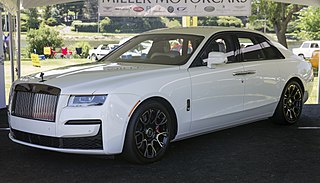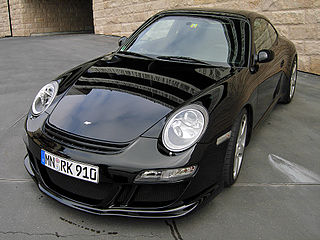
The Volvo C30 is a three-door, front-engine, front-wheel-drive premium compact hatchback, manufactured and marketed by Volvo Cars from 2006 to 2013, in a single generation. Powered by inline-four and straight-five engines, the C30 is a variant of the Volvo S40/V50/C70 range, sharing the same Ford C1/Volvo P1 platform. Volvo marketed the C30 as a premium hatchback / sports coupe.

The Rolls-Royce Phantom is a full-sized luxury saloon car made by Rolls-Royce Motor Cars. Launched in 2003, it was the first Rolls-Royce developed and introduced after BMW purchased the right to use the Rolls-Royce name and logo in 1998. It was the seventh Rolls-Royce design to use the Phantom nameplate.

The Rolls-Royce Phantom IV is a British automobile produced by Rolls-Royce. Only eighteen were made between 1950 and 1956, sold only to buyers whom Rolls-Royce considered worthy of the distinction: the British royal family and heads of state. Sixteen are known to still exist in museums as well as in public and private collections.
Rolls-Royce Motor Cars Limited is a British luxury automobile maker that has operated as a wholly owned subsidiary of BMW AG since 2003 – as the exclusive manufacturer of Rolls-Royce-branded motor cars. The company's administrative and production headquarters are located on the 42-acre (17 ha) Goodwood Estate in Goodwood, West Sussex, England, United Kingdom.

An electric aircraft is an aircraft powered by electricity. Electric aircraft are seen as a way to reduce the environmental effects of aviation, providing zero emissions and quieter flights. Electricity may be supplied by a variety of methods, the most common being batteries. Most have electric motors driving propellers or turbines.

The Chevrolet Volt is a plug-in hybrid car manufactured by General Motors, also marketed in rebadged variants as the Holden Volt in Australia and New Zealand and the Buick Velite 5 in China, and with a different fascia as the Vauxhall Ampera in the United Kingdom and as the Opel Ampera in the remainder of Europe. Volt production ended in February 2019.

The Audi e-tron is a series of electric and hybrid cars shown by Audi from 2009 onwards. In 2012 Audi unveiled a plug-in hybrid version, the A3 Sportback e-tron, released to retail customers in Europe in August 2014, and slated for the U.S. in 2015. A decade after the unveiling of the first e-tron concept at the 2009 International Motor Show Germany, Audi's first fully electric e-tron SUV went into production in 2019.

The Rolls-Royce Ghost is a full-sized luxury car manufactured by Rolls-Royce Motor Cars. The "Ghost" nameplate, named in honour of the Silver Ghost, a car first produced in 1906, was announced in April 2009 at the Auto Shanghai show. The production model was officially unveiled at the 2009 Frankfurt Motor Show. The Ghost Extended Wheelbase was introduced in 2011. During development, the Ghost was known as the "RR04". It was designed as a smaller, "more measured, more realistic car" than the Phantom, aiming for a lower price category for Rolls-Royce models.

A battery electric vehicle (BEV), pure electric vehicle, only-electric vehicle, fully electric vehicle or all-electric vehicle is a type of electric vehicle (EV) that exclusively uses chemical energy stored in rechargeable battery packs, with no secondary source of propulsion. BEVs use electric motors and motor controllers instead of internal combustion engines (ICEs) for propulsion. They derive all power from battery packs and thus have no internal combustion engine, fuel cell, or fuel tank. BEVs include – but are not limited to – motorcycles, bicycles, scooters, skateboards, railcars, watercraft, forklifts, buses, trucks, and cars.

The Smart EQ Fortwo, formerly Smart Fortwo electric drive, smart ed or Smart Fortwo EV, is a battery electric vehicle variant of the Smart Fortwo city car made by Smart. Since 2020, Smart is only selling battery EVs.

The eRuf Model A is a late-2000s all-electric concept sports car built by German automobile manufacturer Ruf Automobile. The car was powered by a UQM Technologies propulsion system. The car has a top speed of 225 km/h (140 mph) and was capable of producing 150 kW of power and 479 lb⋅ft (649 N⋅m) of torque. Estimated range per charge was 250–320 km (155–199 mi), depending on performance level, using iron-phosphate, lithium-ion batteries built by Axeon plc of Great Britain. During coasting the engine works as a generator producing electricity to charge the batteries.

LincVolt is a 1959 Lincoln Continental, owned by musician Neil Young, that was converted into a more fuel-efficient, hybrid demonstrator vehicle.

Johnson Matthey Battery Systems, part of the Johnson Matthey group and formerly called Axeon, designs and manufactures advanced lithium-ion battery systems for electric vehicles and processes over 70 million cells per year. Headquartered in Dundee, Scotland and with operations in Poland and sales offices in Coventry, England, Johnson Matthey Battery Systems produces batteries for all types of electric vehicles including urban delivery vehicles and high performance sports cars.

The Porsche 918 Spyder is a sports car manufactured by German marque Porsche. The 918 Spyder is a plug-in hybrid powered by a mid-mounted naturally aspirated 4.6 L (4,593 cc) V8 engine, developing 447 kW at 8,700 RPM, with two electric motors delivering an additional 210 kW for a combined output of 652 kW (875 hp) and 1,280 N⋅m (944 lbf⋅ft) of torque. The 918 Spyder's 6.8 kWh lithium-ion battery pack delivers an all-electric range of 19 km (12 mi) under the US Environmental Protection Agency's five-cycle tests.

The Ford Focus Electric is a 5-door hatchback electric car that was produced by Ford. The Focus Electric is Ford's second production all-electric vehicle, and was made from December 2011 to May 2018.
UQM Technologies Inc was an American manufacturer of electrical motors, generators, motor controllers, fuel cell compressor systems and hybrid systems for passenger and commercial vehicles. Established in 1967 as Unique Mobility Inc, UQM was based in Longmont, Colorado. UQM's products were sold direct to original equipment manufacturers (OEM).

Boulder Electric Vehicle was a manufacturer of electric-powered commercial vans and trucks based in Lafayette, Colorado. The company produced four CARB-certified models: an electric delivery van, a 15-passenger shuttle, a service body and a flat bed. Boulder Electric Vehicles ended production in September 2014.

Numerous plug-in electric vehicle (EV) fire incidents have taken place since the introduction of mass-production plug-in electric vehicles. As a result of these incidents, the United States Department of Transportation's National Highway Traffic Safety Administration (NHTSA) conducted a study in 2017 to establish whether lithium-ion batteries in plug-electric vehicles pose an exceptional fire hazard. The research looked at whether the high-voltage batteries can cause fires when they are being charged, and when the vehicles are involved in an accident.
Regarding the risk of electrochemical failure, [this] report concludes that the propensity and severity of fires and explosions from the accidental ignition of flammable electrolytic solvents used in Li-ion battery systems are anticipated to be somewhat comparable to or perhaps slightly less than those for gasoline or diesel vehicular fuels. The overall consequences for Li-ion batteries are expected to be less because of the much smaller amounts of flammable solvent released and burning in a catastrophic failure situation.

The Rolls-Royce Phantom is a full-sized luxury saloon manufactured by Rolls-Royce Motor Cars. It is the eighth and current generation of the Rolls-Royce Phantom, debuting in 2017, and the second launched by Rolls-Royce under BMW ownership. It is offered in two wheelbase lengths. This is the current flagship model made by Rolls-Royce Motor Cars.

The Proterra Catalyst is a battery-electric low-floor transit bus that was built by Proterra from 2014 to 2020. The second generation of Proterra's battery-electric buses, it succeeded the earlier EcoRide as the company's flagship product.


















